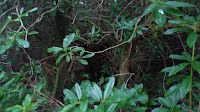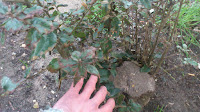 Warming Climate and Irresponsible gardeners
Warming Climate and Irresponsible gardeners
A combination of our climate becoming less harsh, especially in the winter & irresponsible gardeners, growing many varieties of invasive weeds in their gardens; has produced an explosion of evergreen trees and shrubs, mostly around our coastal towns & cities.
Some of these evergreens are native, others are not. But whatever the origin; these trees are running a muck and it would be interesting to find out for sure; why they are doing this.
Pine Trees

Some parts of the Uk's south coast are starting to look like the South of France, with all these pine trees. There are a few different species, which seem to be causing the nuisance, but its unclear where they came from in the first place, they certainly do well here. In some woods, nearly all the tall trees are Pine trees, I wouldn't like to be here in a drought; these things go up like match wood.

The more urban the area; the more pine trees & other evergreens are to be found. This would strongly suggest that they have escaped from gardens, but it is possible also that some may have escaped from commercial plantations as well.
There are allot in gardens and parks, though I suspect most, if not all are self seeded.
Holly

Not a foreign plant, never the less; spreading in the under canopy, like an unstoppable tidal wave.
Why is this otherwise fairly well behaved tree, which should be (and usually is) naturally balanced and attuned to the Eco-system/habitat here; be behaving like this?
Vast areas of heath and woods alike are covered in the stuff. I haven't seen one Hazel!
Bays and Laurels

Worse than the Hollies, this group of similar and related plants spread uncontrollably, throughout woods, heaths and unkempt gardens alike.
Some, like the Cherry-Laural (left) will even devastate areas well inland and will even damage woodland at high altitude. Spreading with the virility of a Rhododendron, over the forest floor and extinguishing the light from all but the very tall trees.

Bay trees are often thought of as a difficult to grow garden herb, which dies if there is a harsh winter and regrows from the base, if you're lucky. But here, on the south coast, they don't have very low winter temperatures and just go on growing. in some areas, they dominate the under canopy completely.
There are many other relatives of these plants; like the Bird Cherry and the Portuguese Laurel, some of these too are joining the invading army of Evergreens; deleting our native plants, from right under our noses.
Holm and Spanish Oaks

The Evergreen Oaks.
These trees thrive on the South coast. Quickly spreading into new areas and waisting no time in grabbing large percentages of the canopy space from our native trees.
Naturally they grows in the South of the temperate zone in Southern Europe, mainly Spain and Portugal. They are close relatives of the Cork Oak, which is famously produced almost exclusively in Portugal.
But why are they here? Blasted gardeners again , I expect. But where ever they came from, one thing is clear; We have a real problem here.
Cotoneaster

Defiantly from people's gardens, this one! A real nuisance!
There are allot of different species of it. Some evergreen, some deciduous and some in between. Many are highly invasive, mainly in Heaths and Hedgerows.
They are spread by Birds and the berries look pretty all through the winter, so people have them in their gardens to give screening, winter colour and to attract the birds. I wonder how many of them are even aware of the damage they are responsible for.
Budlejia
The Butterfly Bush
This one is a menace, mainly around urban areas, be they coastal or otherwise, although it is far more widespread at lower altitudes, spreading quickly and colonising waste areas. Growing more quickly than our native species can and so; swamping them out.

Gardeners tolerate it's appearance in their garden, because it flowers and gets covered in Butterflies, which has an obvious appeal, but many other flowering plants are enjoyed by Butterflies, just as much. So there is no excuse!
Budlejia needs few resources. It grows on sheer rock or quarry faces, as well as from between the mortars of buildings, as seen here; quite a few can be seen, sprouting from brickwork, in this railway arch,to the right.
Today's Coastal Woodland
To me; the above picture looks like 'a scene of destruction'! Compare this with an average picture of pristine English woodland and it is a totally different kind of environment. It is far more like the Evergreen woodland, usually found much further south on the Mediterranean, although many of these invasive weeds come from different corners of the world, including the Himalayas.

Very little space seems uncrowded with dark, engulfing Evergreen. Apart from the odd Oak and the masses of Holly; it essentially is no longer native woodland, scarcely even remotely native.
Plants and animals evolve together and build up Eco-systems. If these coastal areas are a blue print, for what is to come, then we could be looking at many localised mass-extinctions, right up the food chain, as these foreign weeds keep on coming relentlessly and unchecked.
























































